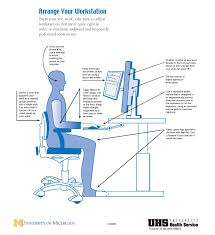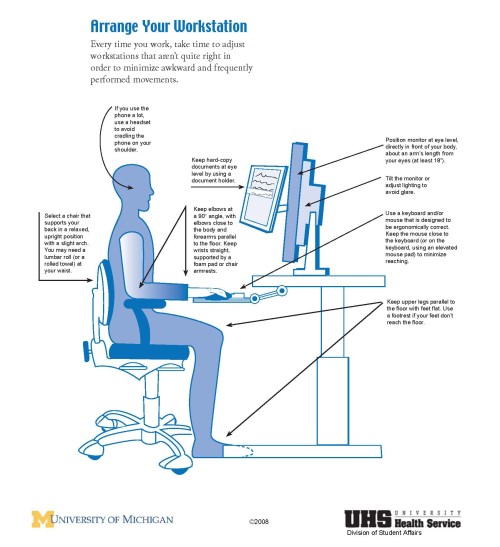BLOG
Office Ergonomics: Your how-to guide
Posted by Dianne Hartwick in Ergonomics, Organization | 0 comments

A comfortable work space can help you feel your best at work. By Mayo Clinic Staff
If you sit behind a desk for hours at a time, you’re not doomed to a career of neck and back pain or sore wrists and fingers. Proper office ergonomics — including correct chair height, adequate equipment spacing and good desk posture — can help you stay comfortable at work.
 Chair Adjust the height of your chair so that your feet rest comfortably on the floor and your knees are about level with your hips. If your chair doesn’t offer lumbar support, place a cushion between the curve in your lower back and the back of the chair.
Chair Adjust the height of your chair so that your feet rest comfortably on the floor and your knees are about level with your hips. If your chair doesn’t offer lumbar support, place a cushion between the curve in your lower back and the back of the chair.
Key object positioning Keep key objects — such as your telephone, stapler or printed materials — close to your body to prevent excessive stretching. Stand up to reach anything that can’t be comfortably reached while sitting.
Mouse position Place your mouse within easy reach on the side of your keyboard. Keep your wrist in a natural and comfortable position when you’re using your mouse.
Wrist rest Use a wrist rest to minimize stress on your wrists and prevent awkward wrist positions. While typing, hold your hands and wrists above the wrist rest. During typing breaks, rest the heels or palms of your hands — not your wrists — on the wrist rest.
Wrist positioning When you’re typing, keep your wrists in a straight, natural position — not bent up, down or to either side.
Headset If you frequently talk on the phone and type or write at the same time, use a headset rather than cradling the phone between your head and neck. Experiment with various styles until you find the headset that works best for you.
Footrest If your chair is too high for you to rest your feet flat on the floor, consider using a footrest. Various types of footrests are available — or get creative and make your own. Try a small stool or a stack of sturdy books.
Posture Center your body in front of your monitor and keyboard. Sit up straight, keeping your thighs horizontal with your knees and at about the same level as your hips. Keep your forearms level or tilted up slightly.
Desk dimensions Generally, the desk should be at least 19 inches (48 centimeters) deep, 30 inches (76 centimeters) wide and, depending on your height, up to 34 inches (86 centimeters) high. Under the desk, make sure there’s clearance for your legs, knees and thighs. Don’t use space under the desk for storage.
Monitor height Place the monitor directly in front of you, about an arm’s length — generally 18 to 28 inches (46 to 71 centimeters) — away. The top of the screen should be slightly below eye level. If glare from fluorescent lighting or sunlight is a problem, turn off some or all of the overhead lights or close the window shades. Place your monitor so that the brightest light source is to the side.

